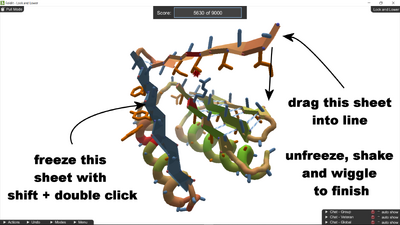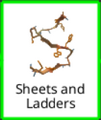
Lock and Lower. Lock (freeze) the sheet on the left, then lower (drag) the sheet sticking up into line with the others.
In this puzzle, one sheet is pointing off into space. A group of three sheets is already bonded together. Another sheet is off to one side, connected to the out-of-line sheet by a short section of loop.
Madde's "Lock and Lower" video
The goal is to pull all five sheets together into one unit, nicely bonded with blue-and-white spirals.
The simple strategy is to freeze just one sheet, then pull the stray sheet into line.
First, shift + double-click on sheet at the left when the puzzle starts. This freezes the entire sheet. Next, drag the out-of-line sheet down into line with the others.
It may help to rotate the protein by dragging on the background, so the bad sheet is pointing toward the top of the screen. Click and drag on the bad sheet. As it comes into line, you should see blue-and-white hydrogen bonds form with the other sheets.
Once you have a good number of bonds, try shaking and wiggling. You may also want to click Unfreeze Protein to free up the first sheet.
If the protein doesn't come together, or sections start to pull apart, you can add bands using shift-click-drag. (You can even add bands while wiggle is running.)
If the simple strategy doesn't work for you, a combination of bands and freezes may be the solution.
First, reset the using control-r or Actions -> Reset Puzzle.
Next, draw bands between the out-of-line sheet and the sheets on either side. Here you'll probably need five or six bands between each sheet. Try to line up the "zigs" on one sheet with the "zags" on the next.
It will probably help to rotate the protein, by clicking and dragging on the white background, before trying to draw bands.
If you wiggle after drawing bands, you'll probably see the sheets that are already bonded start to pull apart, breaking the hydrogen bonds. This is where freezing comes in handy. If you shift-double-click on a sheet, the entire sheet freezes, which prevents it from changing shape. In this case, freezing should help keep the bonded sheets bonded.
If you want, you can draw bands between the bonded sheets instead of freezing. You don't necessarily need to band every hydrogen bond, but at least three or four bands for each pair of sheets is a good idea.
As usual, wiggle and shake to finish. If results are good, you raise your score by unfreezing with the "Unfreeze Protein" button (keyboard shortcut "f"), followed by another round of wiggle-shake-wiggle. Finally, remove bands with the "Remove Bands" button (keyboard shortcut "r") and then wiggle-shake-wiggle one last time.
Technical stuff: this protein looks a more realistic than some of the earlier examples. The simple strategy of freezing just one segment is a good example of "hand folding", which can involve just pulling on part of the protein. But hand-folding this way requires practice, and the protein may pull apart if you don't get things lined up just right. The more complicated strategy using bands and freezes is more time-consuming, but may be more reliable in the long run.

